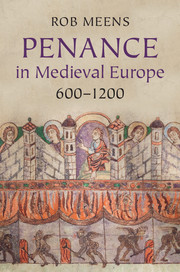Book contents
- Frontmatter
- Dedication
- Contents
- List of Figures
- Acknowledgments
- 1 Introduction
- 2 The late antique legacy
- 3 A new beginning? Penitential practice in the insular world
- 4 Insular texts on the move: penance in Francia and England
- 5 Penance and the Carolingian Reforms
- 6 New penitential territories: the tenth and eleventh centuries
- 7 The twelfth century
- Conclusion
- Appendix 1 The manuscripts of Theodore’s penitential
- Appendix 2 The manuscripts of the Excarpsus Cummeani
- Appendix 3 The manuscripts of the Bede and Egbert penitentials
- Appendix 4 The manuscripts of Halitgar’s penitential
- Sources
- Bibliography
- General index
- Manuscript index
- References
6 - New penitential territories: the tenth and eleventh centuries
Published online by Cambridge University Press: 05 August 2014
- Frontmatter
- Dedication
- Contents
- List of Figures
- Acknowledgments
- 1 Introduction
- 2 The late antique legacy
- 3 A new beginning? Penitential practice in the insular world
- 4 Insular texts on the move: penance in Francia and England
- 5 Penance and the Carolingian Reforms
- 6 New penitential territories: the tenth and eleventh centuries
- 7 The twelfth century
- Conclusion
- Appendix 1 The manuscripts of Theodore’s penitential
- Appendix 2 The manuscripts of the Excarpsus Cummeani
- Appendix 3 The manuscripts of the Bede and Egbert penitentials
- Appendix 4 The manuscripts of Halitgar’s penitential
- Sources
- Bibliography
- General index
- Manuscript index
- References
Summary
In the Carolingian Church penance had become a regular feature of the life of the clergy and the laity. As a consequence many penitential books were composed to assist priests in their task of hearing confession. Such penitential manuals had been copied in large quantities and were available in the small collections of books of country churches. After this blossoming of penitential literature, which was characterized by a production of new texts, distributing these texts by copying them and discussing their models and functions, the tenth and eleventh centuries form a contrast. In the northern Frankish regions, the centre of production and discussions of penitential texts during the Carolingian era, we no longer see a thriving production of new penitential texts. This decrease fits in with a more general decline in the production of texts and manuscripts that has been observed for this period. This decline can partly be explained by the extensive production of texts and manuscripts in the preceding era, which seems to have met many demands. Given the fact that parchment manuscripts are durable products, the Carolingian copies probably remained in use in the following centuries. A well-stocked parish bookshelf did not need instant renewal. The conservative nature of the tenth- and eleventh-century liturgical developments did not create a need for new texts, as is shown, for instance, by the fact that earlier penitential handbooks continued to be reproduced. The penitentials attributed to Bede and Egbert, for example, were copied at least eighteen times in this period.
- Type
- Chapter
- Information
- Penance in Medieval Europe, 600–1200 , pp. 140 - 189Publisher: Cambridge University PressPrint publication year: 2014



